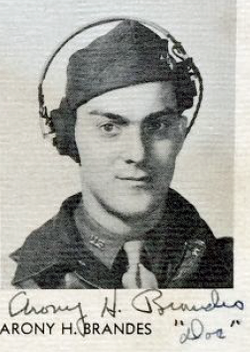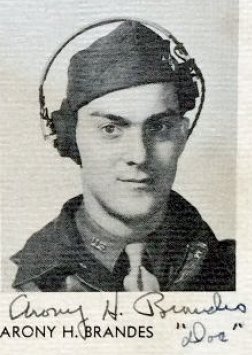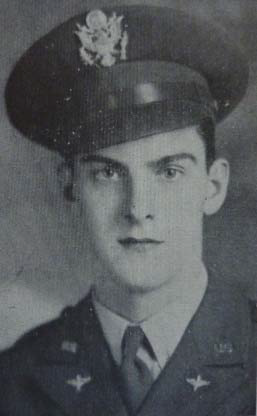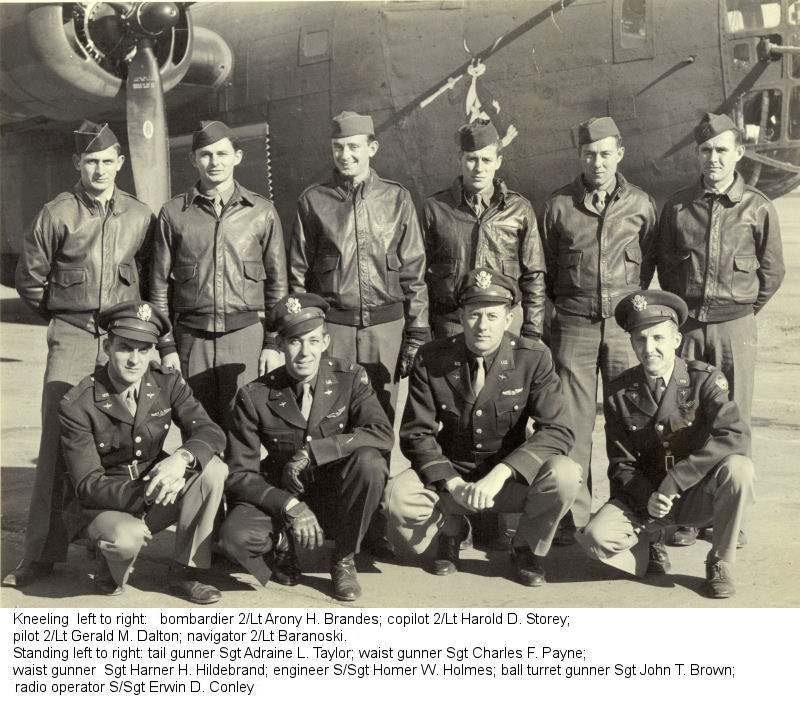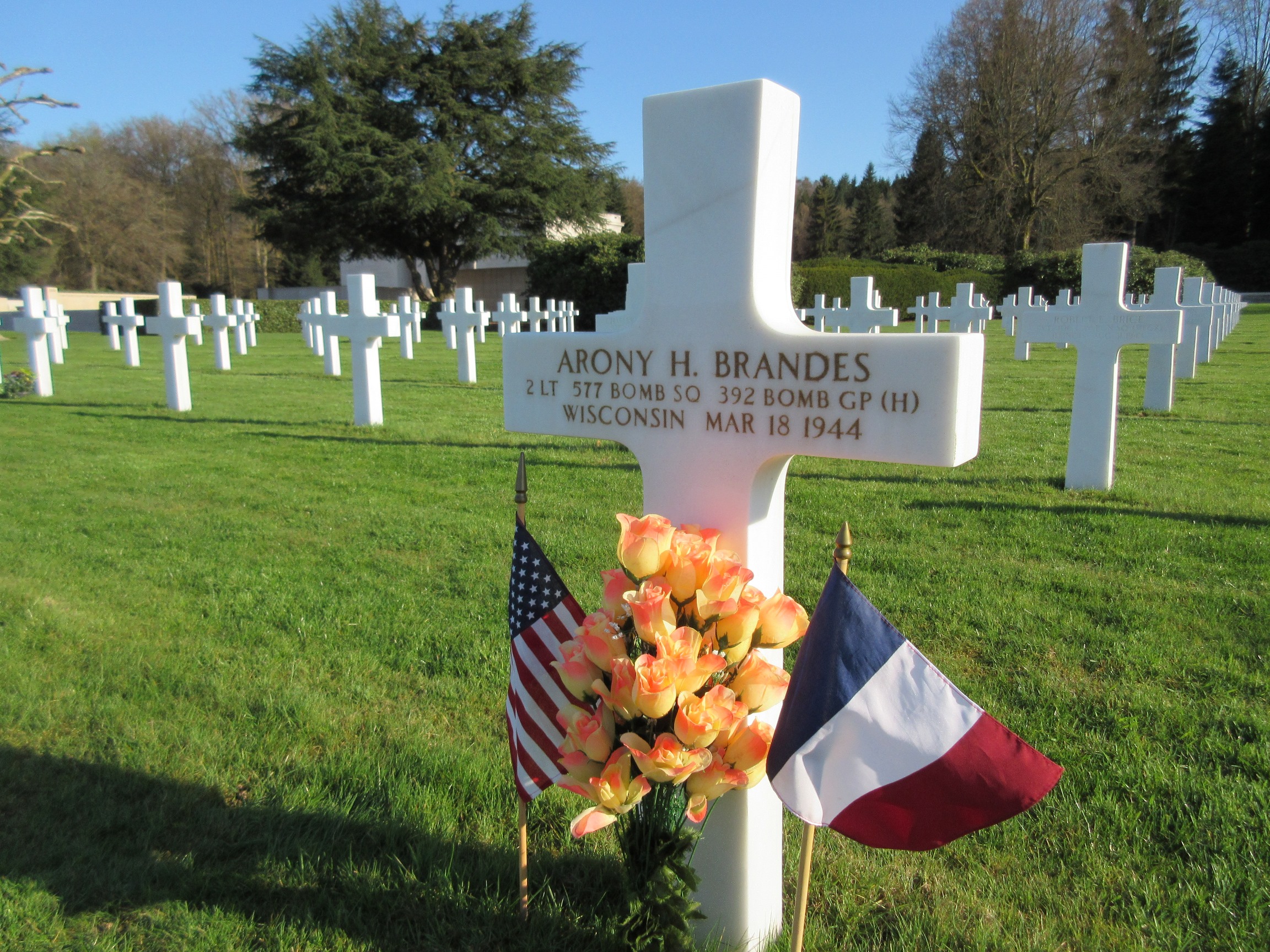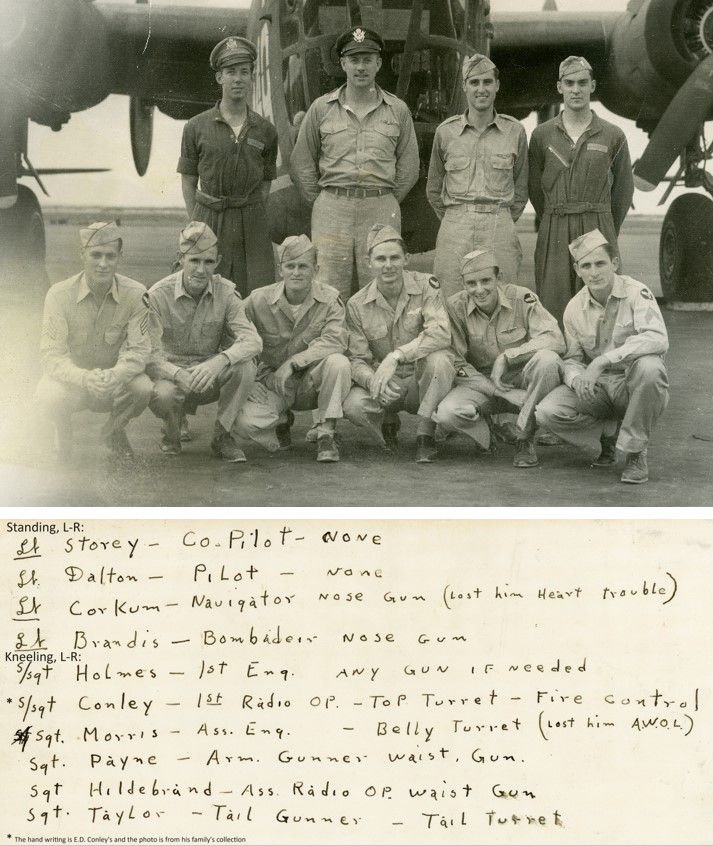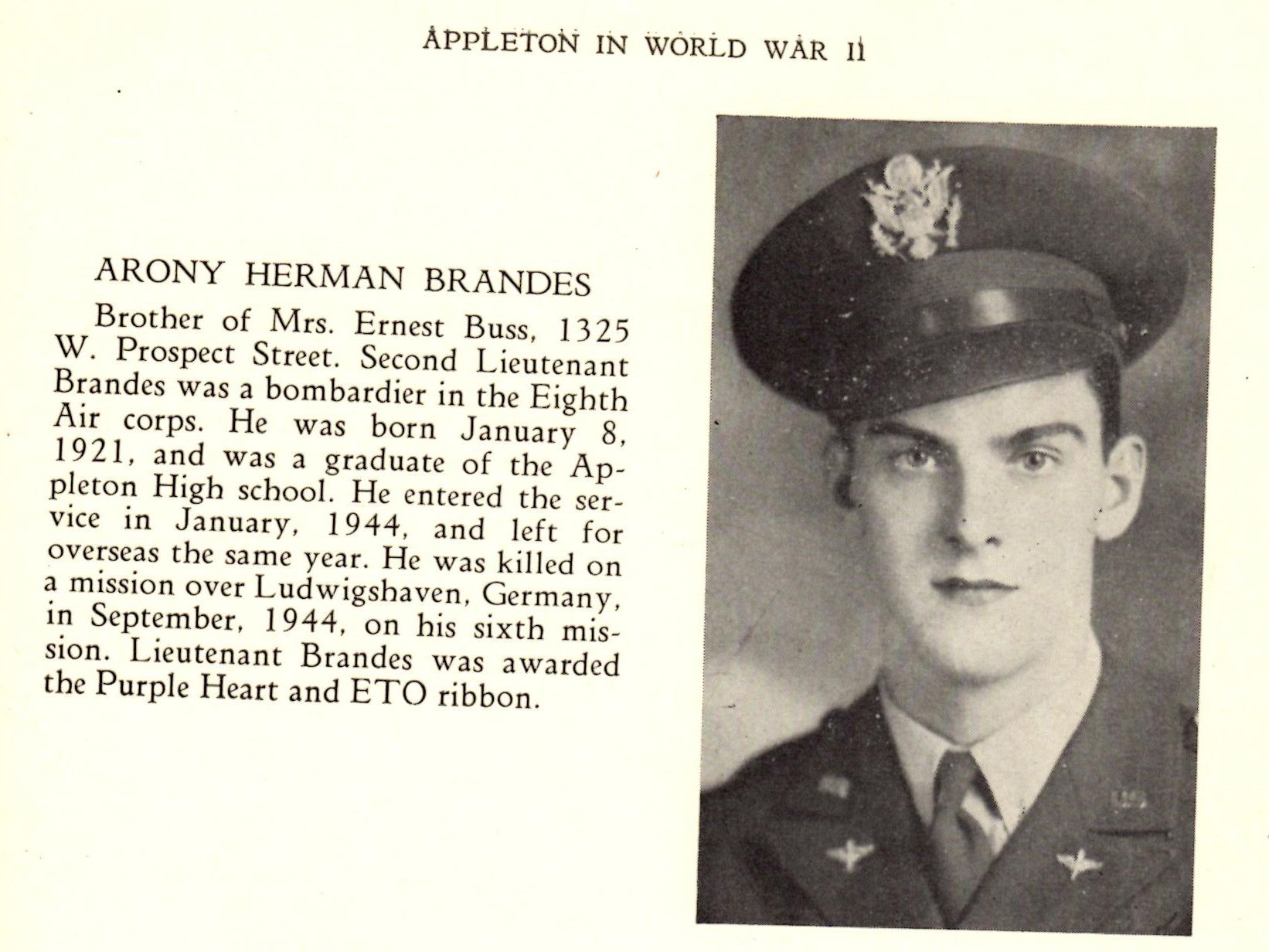FAG Member Jeffrey R. Kregel -
Please give credit to the following: The students of History 357: The Second World War Department of History, University of Wisconsin-Madison -
This report is addressed to the staff and caretakers of The Épinal American Cemetery and Memorial of France. It includes information regarding the life and service record of Second Lieutenant Arony Herman Brandes. The authors of this modest research project hope that this information will be of help and interest to those who oversee this American Veteran's final resting place, and will bear witness to the great sacrifice of one American soldier and the many French people who helped his only surviving comrade reach safety.
Arony H. Brandes was the second of three children born to parents William and Emma Brandes on January 18, 1921 in Appleton, a small city in central Wisconsin. Brandes was of German descent, his grandfather having emigrated from to the United States and settled in Wisconsin in the final decades of the nineteenth century. In 1930, when Brandes was only nine years of age, his father died of an illness, and in 1938 his mother also passed away. By this time his eldest sister Adeline had married, so Brandes and his younger sister Eldora went to live with Mr. and Mrs. Louis Lautenschlaeger; his uncle and aunt. Brandes remained in school until his third year of high school, after which he began working as a mechanic. He continued with this work until February 4, 1942, when he enlisted in the United States military in Milwaukee, Wisconsin at the age of 21.
Brandes became a member of The 577th Squadron trained under the Second Air Force, which was assigned to the Eighth Bomber Command in England for the duration of the war. The 392nd Bomber Group was stationed at RAF Wendling near Norfolk, England and began carrying out missions in September of 1943. The 392nd flew a total of 285 combat missions, suffering 1552 casualties including 835 KIA and 184 aircraft lost while dropping 17,452 tons of bombs on enemy targets. Brandes held the position of Bombardier, and along with nine other men made up the crew of a B-24 liberator which they named the Ambling Okie.
Arony H. Brandes died at the age of 23 on March 18, 1944 over Le Ployron France while on a mission to bomb Southern Germany. On this day, the 392nd set out to complete mission #53 in Southern Germany. The men were told that their targets were the German cities of Friedrichshafen and Russleheim, with the former being the primary target. This mission would turn out to be the most costly for the 392nd as it led to its heaviest losses of any raid during the war. In total, fourteen aircraft and crews were lost and nine others were damaged by enemy fighters and flak, amounting to 154 casualties. Second Lieutenant Brandes was one of these casualties.
After departing England, Brandes' B-24, piloted by Second Lieutenant Dalton, became caught in a violent propeller wash and collided with another plane piloted by Lieutenant Feran. As Dalton's plane got caught in the propeller wash it could not avoid hitting Feran's aircraft as it was simultaneously falling out of formation. The crash occurred over France while en route to their German targets.
The following information comes from the only survivor of the crash, waist-gunner Sergeant Payne:
"On the way to Friedrichshafen, tail-end Charlie of our squadron peeled off and, since we were flying spare, we moved up into his position. Later he came back toward us and his rudder hit our right wing between the outboard engine and the wing tip. Our plane went up. I threw off my flak suit, grabbed my parachute, and reached for the waist window. The plane broke in two where I was standing, and I fell out at about 23,000 feet." The right wing and tail of the Ambling Okie were both broken off in the collision, along with the left tail and wings of Lt Feran's plane. After jumping from the plane, Payne had to fall freely until reaching a height of about 3,000 feet before he could open his parachute. The planes crashed over the village of Le Ployron, southeast of Amiens. The entire territory was occupied by the Germans. Payne, the only survivor out of twenty, was then quickly taken in by French civilians. The Frenchmen hid him in a large cement water tank near the crash site, and eventually assisted him until he crossed into Spain. They then proceeded to bury twenty coffins, one being empty, in order to convince the German officials that there were no survivors.
Much information about the details of the crash were provided by French witnesses. Several years after the war, Roger Lavasseur of Le Ployron sent a letter to the mother of one of the men killed in the crash and described the event in which he bore witness.
The translated letter reads:
"Excuse me, first, for taking the liberty of writing you, but I consider this task a duty. As a Lieutenant of the French Forces of the Interior and Chief of the Local Resistance Unit, I was eyewitness of the unfortunate accident which cost the life of your son and of eighteen of his comrades. Having picked up the only survivor, Charles Payne of Lake Placid, Florida, it was through him that I procured your address.
These are the circumstances of the accident: Saturday, March 18th, 1944, at one-thirty in the afternoon a large formation of Liberators passed over, flying very high in groups of six. Suddenly for an unknown reason, one of the planes detached itself and telescoped into the plane in which your son was flying. Immediately the two planes fell, rolling over each other. The rudders were torn off, the wings buckled and crushed by being struck by the propellers. One plane appeared to be about to crash on the village but in a last effort, the pilot, using full throttle, succeeded, for some seconds, in maintaining altitude. But the plane, with its load of bombs and fuel, crashed into the ground at some distance from the town. The tanks exploded, the bombs blew up, the plane was cut to pieces, and immediately there arose an immense fire. The other plane crashed near the railroad, 150 meters from the little house where we live. The children and their mother, who were alone, were terrified by the fire and explosions of the bombs which were, fortunately, not incendiary, which fact saved them from destruction. During this time Payne, who alone had had time to strap on his parachute, jumped, and after a free fall of 4,000 meters, opened his parachute and descended slowly the remaining 3,000 meters, and landed. Upon his arrival on the ground one of my young comrades in the Resistance Movement succeeded in getting him away ahead of the Germans, who arrived rapidly on the scene, and hid him in the water reservoir of the village where he remained until nightfall.
The Commandant of the German Police Force ordered the Mayor of our village to have the victims buried near their planes. Interposing myself, I obtained, with the support of three young German pilots, a certificate at a nearby hospital which expressed clearly in French the right to bury them in the community cemetery. I obtained also, upon our promise that all would be ready by one o'clock the following afternoon, the right to place them in coffins and immediately, with the aid of young comrades, we picked up the burned bodies, which we could nevertheless recognize. Only four gunners from the back … without parachutes, fell free of the planes, their bodies remaining intact and unburned. Your son was one of these four. Unfortunately, they were robbed of all their personal possessions by the Germans, except for some rings which were turned over to the proper organizations. The victims were then placed in the church, guarded by a moved and sympathetic crowd. During this time other comrades dug the grave, for we wished that all should be done by the hands of friends. A great crowd came from everywhere and pressed about the church. The Germans charged with the burial were furious. The officers forbade the priest to follow any religious service. The disgruntled soldiers made the crowd draw back, menacing them with their fists. Then they seemed satisfied in perceiving that we, ourselves, would do the burying and left rapidly. Even though there were only nineteen victims, we buried twenty coffins. Then the crowd covered the tombs abundantly with flowers and after that they were carefully and reverently cared for and decorated by the young men and women of the village.
…Hoping that my letter will be a source of precious comfort to you in knowing in detail the last moments of him who is dear to you, I ask you to accept, dear Madam, the assurance of my respect and devotion."
As the planes were filled with incendiary bombs, flames erupted upon impact leaving very little evidence behind. Of the nineteen bodies found, fifteen of them were identifiable
because of their identification tags, leaving four to be unidentifiable by the German officials. The remains of these men were buried in a common grave in near the crash site in Le Ployron, France. Brandes body was one of these. However, upon moving the graves to the United States Military Cemetery in Le Solers, France, American officials were able to use Tooth charts along with marks of clothing to identify the remains of Second Lieutenant Arony H. Brandes. He was then permanently interred at Épinal American Cemetery and Memorial. Brandes was unmarried and had no children. He was survived only by his two married sisters. His eldest sister, Adeline, had children and many grandchildren. Although they have never met him,. Brandes has many relatives who are still living in Wisconsin today.
This information was compiled mainly from the Individual Deceased Personnel File (IDPF) provided to us by the US Army, US Census records, the online database Newspaper
ARCHIVE, and the researching team with the 392nd Bomb Group who created the www.B24.Net website providing a rich source of detailed information about World War II American Veterans of the 392nd.
------------------------------------------------------------
Bombardier 2nd/Lt. Arony H. Brandes KIA
Hometown: Sheboygan, Wisconsin
Squadron:577th BS 392nd Bomb Group
Service # O-684938
Awards: Purple Heart
Pilot 2nd/Lt. Gerald M. Dalton KIA
Target: Friedrichshafen
Missing Air Crew Report Details
USAAF MACR#:#03320
Date Lost: 18-Mar-44
Serial Number: #41 -29174
Aircraft Model B-24
Aircraft Letter:"R"
Aircraft Name: "AMBLING OKIE" 25th Mission
Location: North of Le Ployron, France
Cause: mid-air collision
The mission this day would see the 392nd suffer its heaviest losses, both aircraft and aircrew members, of any individual raid ever flown during its combat experience in World War II. Before the mission was completed, (14) aircraft and crews would be lost and (9) other ships damaged by fighters and flak, all totaling (154) casualties. General briefing for (28) aircrews was conducted between 0400-0530 hours.
MISSION LOSS CIRCUMSTANCES: An eye-witness account from returning aircrew members of the Group stated that the Dalton aircraft had been caught in violent propeller 'wash' and suffered a mid-air collision with another 392nd ship which at the time was falling back out of formation. The other plane was later determined to be 1/Lt. Feran's (#41-28651). The event was noted to have occurred at 1233 hours over France enroute at position 49-34N, 02-16E. German ground reports later confirmed (by tail number) that these two ships had indeed collided in mid-air.
German ground reports confirmed that the Dalton and Feran planes went down in very close proximity to each other. Several reports noted the 'mixing' of names comprised of both aircrews during recovery of the bodies and later their initial burials together in the same location. All 19 crewmen from both aircraft who were killed were accounted for in these documents. The primary German Reports dealing with these facts were KU #1236, from Headquarters Airfield 5/Xl Mondidier and KU #1237. Investigation Report #5/2072 on the Dalton ship, #41-29174, stated this Liberator had collided with another B-24 (Report #5/2073) at 1232 hours in mid-air, and had crashed about 800 meters north of Le Ployron, France, eight kilometers south of Mondidier. It stated this ship was completely destroyed and burned after the crash in all probability "from the incendiary bombs it had been carrying which contained liquid fuel". All crewmembers were found dead; and no Group identification was discernible except a blue "D" in a white circle, and a portion of the rudder fin with an 'R' below the serial numbers reported.
INDIVIDUAL ACCOUNTS OF CREWMEN FATES: The only survivor report was waist gunner Sgt Payne. Payne, was helped by the French underground forces and successfully evaded. After he returned to England on 4 July 1944, he made a statement to U.S. European Military Intelligence authorities concerning this mishap. The Dalton ship had a section of the right wing torn off behind the #4 engine as well as a portion of the tail assembly. The other plane (Feran's) had lost its left tail section and both wings. The collision occurred at 23,000 feet and Payne believed that he was the only one of his crew who was wearing a parachute at the time of this accident. The French people who helped him evade had told him that three officers of the Dalton crew were found clear of the wreckage; none was wearing a chute. They also said these crewmembers were identified at the crash site by their ID tags. Payne further stated that according to reports given to him, all crewmen on both aircraft had perished. In his Escape and Evasion Report (#823), Sgt Payne provided these details. "On the way to Friedrichshafen, tail-end Charlie of our squadron peeled off and, since we were flying spare, we moved up into his position. Later he came back toward us and his rudder hit our right wing between the outboard engine and the wing tip. Our plane went up. I threw off my flak suit, grabbed my parachute, and reached for the waist window. The plane broke in two where I was standing, and I fell out at about 23,000 feet." Damage caused by this collision: The right wing beyond the #4 engine had broken off and the tail was broken off from the waist. The left tail of the other plane (Lt Feran's, #42-28651) was broken off as were parts of both wings.
BURIAL RECORDS: All casualties of this aircrew and 1/Lt Feran's (MACR #3324) were interred in a cemetery at the eastern outskirts of Le Ployron, France. Three Dalton crewmembers were not identifiable by the Germans; they were later determined to be 2/Lt Sherman, 2/Lt. Brandes and Sgt Taylor. The French civilians buried 20 coffins at Le Ployron Cemetery in an effort to convince the Germans that everyone in the two planes had been killed and thus help S/Sgt Payne avoid capture. Three of the crewmen are now interred in the Epinal American Cemetery, four miles south of Epinal (Voges), France, on the west bank of the Moselle River: Dalton (Grave B-25-22); Brandes (Grave A-17-11); and Brown (Grave B-37-51).
Crew of "AMBLING OKIE"
2Lt. Gerald M. Dalton Pilot KIA
2Lt. Harold D. Storey Co Pilot KIA
2Lt. Phillip Sherman Navigator KIA
2nd/Lt. Arony H. Brandes Bombardier KIA
S/Sgt. Homer W. Holmes Engineer KIA
S/Sgt. Erwin D. Conley Radio Op. KIA
Sgt. John T. Brown Gunner KIA
S/SGT Charles F. Payne Gunner EVD
Sgt. Harner H. Hildebrand Gunner KIA
Sgt. Adraine L. Taylor Gunner
FAG Member Jeffrey R. Kregel -
Please give credit to the following: The students of History 357: The Second World War Department of History, University of Wisconsin-Madison -
This report is addressed to the staff and caretakers of The Épinal American Cemetery and Memorial of France. It includes information regarding the life and service record of Second Lieutenant Arony Herman Brandes. The authors of this modest research project hope that this information will be of help and interest to those who oversee this American Veteran's final resting place, and will bear witness to the great sacrifice of one American soldier and the many French people who helped his only surviving comrade reach safety.
Arony H. Brandes was the second of three children born to parents William and Emma Brandes on January 18, 1921 in Appleton, a small city in central Wisconsin. Brandes was of German descent, his grandfather having emigrated from to the United States and settled in Wisconsin in the final decades of the nineteenth century. In 1930, when Brandes was only nine years of age, his father died of an illness, and in 1938 his mother also passed away. By this time his eldest sister Adeline had married, so Brandes and his younger sister Eldora went to live with Mr. and Mrs. Louis Lautenschlaeger; his uncle and aunt. Brandes remained in school until his third year of high school, after which he began working as a mechanic. He continued with this work until February 4, 1942, when he enlisted in the United States military in Milwaukee, Wisconsin at the age of 21.
Brandes became a member of The 577th Squadron trained under the Second Air Force, which was assigned to the Eighth Bomber Command in England for the duration of the war. The 392nd Bomber Group was stationed at RAF Wendling near Norfolk, England and began carrying out missions in September of 1943. The 392nd flew a total of 285 combat missions, suffering 1552 casualties including 835 KIA and 184 aircraft lost while dropping 17,452 tons of bombs on enemy targets. Brandes held the position of Bombardier, and along with nine other men made up the crew of a B-24 liberator which they named the Ambling Okie.
Arony H. Brandes died at the age of 23 on March 18, 1944 over Le Ployron France while on a mission to bomb Southern Germany. On this day, the 392nd set out to complete mission #53 in Southern Germany. The men were told that their targets were the German cities of Friedrichshafen and Russleheim, with the former being the primary target. This mission would turn out to be the most costly for the 392nd as it led to its heaviest losses of any raid during the war. In total, fourteen aircraft and crews were lost and nine others were damaged by enemy fighters and flak, amounting to 154 casualties. Second Lieutenant Brandes was one of these casualties.
After departing England, Brandes' B-24, piloted by Second Lieutenant Dalton, became caught in a violent propeller wash and collided with another plane piloted by Lieutenant Feran. As Dalton's plane got caught in the propeller wash it could not avoid hitting Feran's aircraft as it was simultaneously falling out of formation. The crash occurred over France while en route to their German targets.
The following information comes from the only survivor of the crash, waist-gunner Sergeant Payne:
"On the way to Friedrichshafen, tail-end Charlie of our squadron peeled off and, since we were flying spare, we moved up into his position. Later he came back toward us and his rudder hit our right wing between the outboard engine and the wing tip. Our plane went up. I threw off my flak suit, grabbed my parachute, and reached for the waist window. The plane broke in two where I was standing, and I fell out at about 23,000 feet." The right wing and tail of the Ambling Okie were both broken off in the collision, along with the left tail and wings of Lt Feran's plane. After jumping from the plane, Payne had to fall freely until reaching a height of about 3,000 feet before he could open his parachute. The planes crashed over the village of Le Ployron, southeast of Amiens. The entire territory was occupied by the Germans. Payne, the only survivor out of twenty, was then quickly taken in by French civilians. The Frenchmen hid him in a large cement water tank near the crash site, and eventually assisted him until he crossed into Spain. They then proceeded to bury twenty coffins, one being empty, in order to convince the German officials that there were no survivors.
Much information about the details of the crash were provided by French witnesses. Several years after the war, Roger Lavasseur of Le Ployron sent a letter to the mother of one of the men killed in the crash and described the event in which he bore witness.
The translated letter reads:
"Excuse me, first, for taking the liberty of writing you, but I consider this task a duty. As a Lieutenant of the French Forces of the Interior and Chief of the Local Resistance Unit, I was eyewitness of the unfortunate accident which cost the life of your son and of eighteen of his comrades. Having picked up the only survivor, Charles Payne of Lake Placid, Florida, it was through him that I procured your address.
These are the circumstances of the accident: Saturday, March 18th, 1944, at one-thirty in the afternoon a large formation of Liberators passed over, flying very high in groups of six. Suddenly for an unknown reason, one of the planes detached itself and telescoped into the plane in which your son was flying. Immediately the two planes fell, rolling over each other. The rudders were torn off, the wings buckled and crushed by being struck by the propellers. One plane appeared to be about to crash on the village but in a last effort, the pilot, using full throttle, succeeded, for some seconds, in maintaining altitude. But the plane, with its load of bombs and fuel, crashed into the ground at some distance from the town. The tanks exploded, the bombs blew up, the plane was cut to pieces, and immediately there arose an immense fire. The other plane crashed near the railroad, 150 meters from the little house where we live. The children and their mother, who were alone, were terrified by the fire and explosions of the bombs which were, fortunately, not incendiary, which fact saved them from destruction. During this time Payne, who alone had had time to strap on his parachute, jumped, and after a free fall of 4,000 meters, opened his parachute and descended slowly the remaining 3,000 meters, and landed. Upon his arrival on the ground one of my young comrades in the Resistance Movement succeeded in getting him away ahead of the Germans, who arrived rapidly on the scene, and hid him in the water reservoir of the village where he remained until nightfall.
The Commandant of the German Police Force ordered the Mayor of our village to have the victims buried near their planes. Interposing myself, I obtained, with the support of three young German pilots, a certificate at a nearby hospital which expressed clearly in French the right to bury them in the community cemetery. I obtained also, upon our promise that all would be ready by one o'clock the following afternoon, the right to place them in coffins and immediately, with the aid of young comrades, we picked up the burned bodies, which we could nevertheless recognize. Only four gunners from the back … without parachutes, fell free of the planes, their bodies remaining intact and unburned. Your son was one of these four. Unfortunately, they were robbed of all their personal possessions by the Germans, except for some rings which were turned over to the proper organizations. The victims were then placed in the church, guarded by a moved and sympathetic crowd. During this time other comrades dug the grave, for we wished that all should be done by the hands of friends. A great crowd came from everywhere and pressed about the church. The Germans charged with the burial were furious. The officers forbade the priest to follow any religious service. The disgruntled soldiers made the crowd draw back, menacing them with their fists. Then they seemed satisfied in perceiving that we, ourselves, would do the burying and left rapidly. Even though there were only nineteen victims, we buried twenty coffins. Then the crowd covered the tombs abundantly with flowers and after that they were carefully and reverently cared for and decorated by the young men and women of the village.
…Hoping that my letter will be a source of precious comfort to you in knowing in detail the last moments of him who is dear to you, I ask you to accept, dear Madam, the assurance of my respect and devotion."
As the planes were filled with incendiary bombs, flames erupted upon impact leaving very little evidence behind. Of the nineteen bodies found, fifteen of them were identifiable
because of their identification tags, leaving four to be unidentifiable by the German officials. The remains of these men were buried in a common grave in near the crash site in Le Ployron, France. Brandes body was one of these. However, upon moving the graves to the United States Military Cemetery in Le Solers, France, American officials were able to use Tooth charts along with marks of clothing to identify the remains of Second Lieutenant Arony H. Brandes. He was then permanently interred at Épinal American Cemetery and Memorial. Brandes was unmarried and had no children. He was survived only by his two married sisters. His eldest sister, Adeline, had children and many grandchildren. Although they have never met him,. Brandes has many relatives who are still living in Wisconsin today.
This information was compiled mainly from the Individual Deceased Personnel File (IDPF) provided to us by the US Army, US Census records, the online database Newspaper
ARCHIVE, and the researching team with the 392nd Bomb Group who created the www.B24.Net website providing a rich source of detailed information about World War II American Veterans of the 392nd.
------------------------------------------------------------
Bombardier 2nd/Lt. Arony H. Brandes KIA
Hometown: Sheboygan, Wisconsin
Squadron:577th BS 392nd Bomb Group
Service # O-684938
Awards: Purple Heart
Pilot 2nd/Lt. Gerald M. Dalton KIA
Target: Friedrichshafen
Missing Air Crew Report Details
USAAF MACR#:#03320
Date Lost: 18-Mar-44
Serial Number: #41 -29174
Aircraft Model B-24
Aircraft Letter:"R"
Aircraft Name: "AMBLING OKIE" 25th Mission
Location: North of Le Ployron, France
Cause: mid-air collision
The mission this day would see the 392nd suffer its heaviest losses, both aircraft and aircrew members, of any individual raid ever flown during its combat experience in World War II. Before the mission was completed, (14) aircraft and crews would be lost and (9) other ships damaged by fighters and flak, all totaling (154) casualties. General briefing for (28) aircrews was conducted between 0400-0530 hours.
MISSION LOSS CIRCUMSTANCES: An eye-witness account from returning aircrew members of the Group stated that the Dalton aircraft had been caught in violent propeller 'wash' and suffered a mid-air collision with another 392nd ship which at the time was falling back out of formation. The other plane was later determined to be 1/Lt. Feran's (#41-28651). The event was noted to have occurred at 1233 hours over France enroute at position 49-34N, 02-16E. German ground reports later confirmed (by tail number) that these two ships had indeed collided in mid-air.
German ground reports confirmed that the Dalton and Feran planes went down in very close proximity to each other. Several reports noted the 'mixing' of names comprised of both aircrews during recovery of the bodies and later their initial burials together in the same location. All 19 crewmen from both aircraft who were killed were accounted for in these documents. The primary German Reports dealing with these facts were KU #1236, from Headquarters Airfield 5/Xl Mondidier and KU #1237. Investigation Report #5/2072 on the Dalton ship, #41-29174, stated this Liberator had collided with another B-24 (Report #5/2073) at 1232 hours in mid-air, and had crashed about 800 meters north of Le Ployron, France, eight kilometers south of Mondidier. It stated this ship was completely destroyed and burned after the crash in all probability "from the incendiary bombs it had been carrying which contained liquid fuel". All crewmembers were found dead; and no Group identification was discernible except a blue "D" in a white circle, and a portion of the rudder fin with an 'R' below the serial numbers reported.
INDIVIDUAL ACCOUNTS OF CREWMEN FATES: The only survivor report was waist gunner Sgt Payne. Payne, was helped by the French underground forces and successfully evaded. After he returned to England on 4 July 1944, he made a statement to U.S. European Military Intelligence authorities concerning this mishap. The Dalton ship had a section of the right wing torn off behind the #4 engine as well as a portion of the tail assembly. The other plane (Feran's) had lost its left tail section and both wings. The collision occurred at 23,000 feet and Payne believed that he was the only one of his crew who was wearing a parachute at the time of this accident. The French people who helped him evade had told him that three officers of the Dalton crew were found clear of the wreckage; none was wearing a chute. They also said these crewmembers were identified at the crash site by their ID tags. Payne further stated that according to reports given to him, all crewmen on both aircraft had perished. In his Escape and Evasion Report (#823), Sgt Payne provided these details. "On the way to Friedrichshafen, tail-end Charlie of our squadron peeled off and, since we were flying spare, we moved up into his position. Later he came back toward us and his rudder hit our right wing between the outboard engine and the wing tip. Our plane went up. I threw off my flak suit, grabbed my parachute, and reached for the waist window. The plane broke in two where I was standing, and I fell out at about 23,000 feet." Damage caused by this collision: The right wing beyond the #4 engine had broken off and the tail was broken off from the waist. The left tail of the other plane (Lt Feran's, #42-28651) was broken off as were parts of both wings.
BURIAL RECORDS: All casualties of this aircrew and 1/Lt Feran's (MACR #3324) were interred in a cemetery at the eastern outskirts of Le Ployron, France. Three Dalton crewmembers were not identifiable by the Germans; they were later determined to be 2/Lt Sherman, 2/Lt. Brandes and Sgt Taylor. The French civilians buried 20 coffins at Le Ployron Cemetery in an effort to convince the Germans that everyone in the two planes had been killed and thus help S/Sgt Payne avoid capture. Three of the crewmen are now interred in the Epinal American Cemetery, four miles south of Epinal (Voges), France, on the west bank of the Moselle River: Dalton (Grave B-25-22); Brandes (Grave A-17-11); and Brown (Grave B-37-51).
Crew of "AMBLING OKIE"
2Lt. Gerald M. Dalton Pilot KIA
2Lt. Harold D. Storey Co Pilot KIA
2Lt. Phillip Sherman Navigator KIA
2nd/Lt. Arony H. Brandes Bombardier KIA
S/Sgt. Homer W. Holmes Engineer KIA
S/Sgt. Erwin D. Conley Radio Op. KIA
Sgt. John T. Brown Gunner KIA
S/SGT Charles F. Payne Gunner EVD
Sgt. Harner H. Hildebrand Gunner KIA
Sgt. Adraine L. Taylor Gunner
Gravesite Details
Entered the Service from Wisconsin.
Family Members
Sponsored by Ancestry
Advertisement
Advertisement
